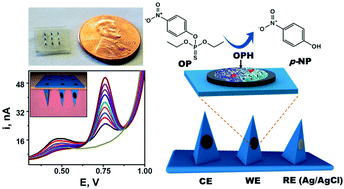A microneedle biosensor for minimally-invasive transdermal detection of nerve agents
Abstract
A microneedle electrochemical biosensor for the minimally invasive detection of organophosphate (OP) chemical agents is described. The new sensor relies on the coupling of the effective biocatalytic action of organophosphorus hydrolase (OPH) with a hollow-microneedle modified carbon-paste array electrode transducer, and involves rapid square-wave voltammetric (SWV) measurements of the p-nitrophenol product of the OPH enzymatic reaction in the presence of the OP substrate. The scanning-potential SWV transduction mode offers an additional dimension of selectivity compared to common fixed-potential OPH-amperometric biosensors. The microneedle device offers a highly linear response for methyl paraoxon (MPOx) over the range of 20–180 μM, high selectivity in the presence of excess co-existing ascorbic acid and uric acid and a high stability sensor upon exposure to the interstitial fluid (ISF). The OPH microneedle sensor was successfully tested ex vivo using mice skin samples exposed to MPOx, demonstrating its promise for minimally-invasive monitoring of OP agents and pesticides and as a wearable sensor for detecting toxic compounds, in general.

- This article is part of the themed collection: Bioanalytical Sensors


 Please wait while we load your content...
Please wait while we load your content...